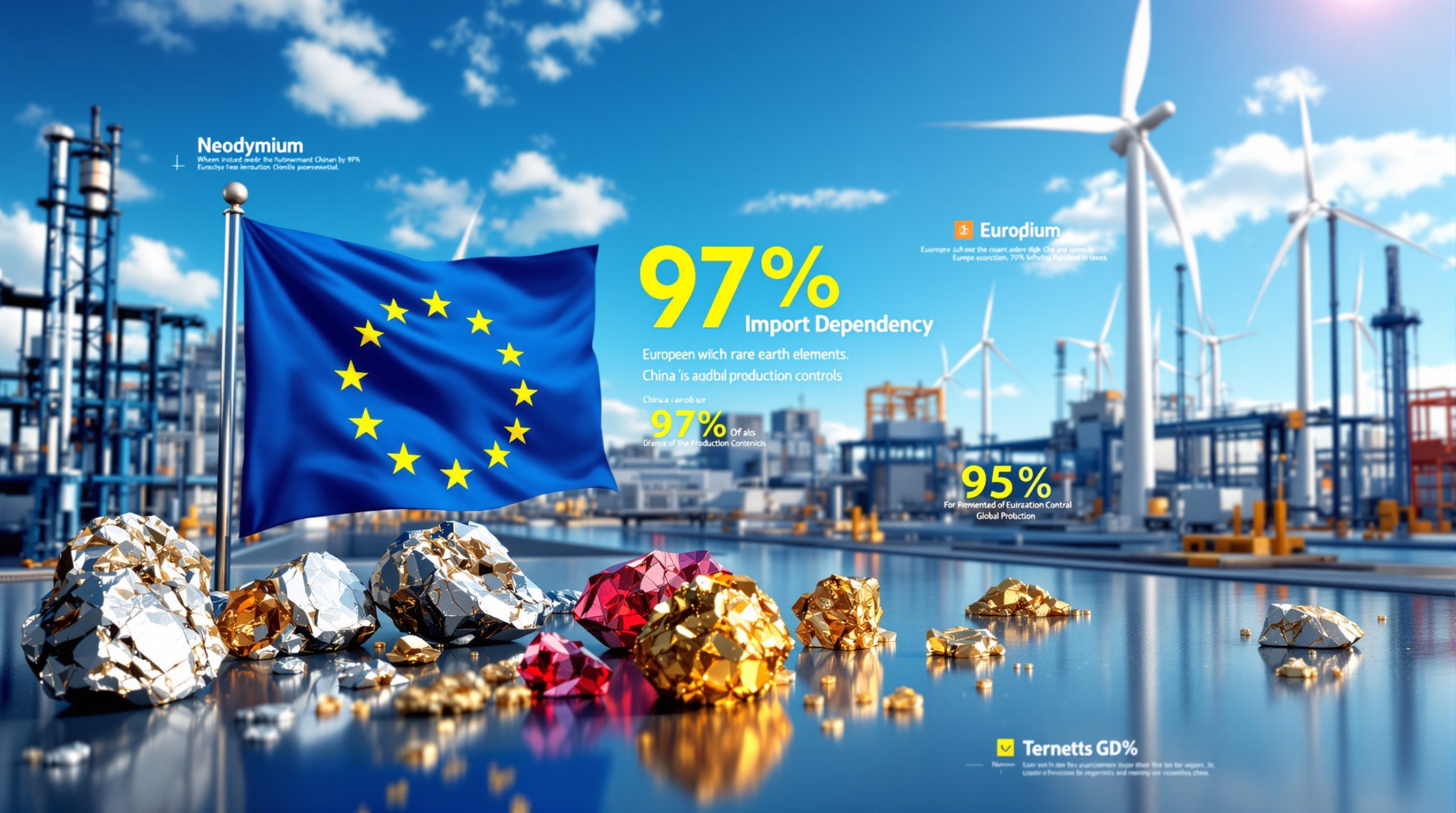Understanding the US-China Rare Earth Trade Framework
The global rare earth minerals market experienced significant volatility following diplomatic negotiations between Washington and Beijing that established new parameters for critical materials trade. This US-China rare earth trade truce represents a fundamental shift in supply chain dynamics for elements essential to modern technology, defense systems, and renewable energy infrastructure.
The bilateral framework addresses immediate tensions while leaving underlying structural vulnerabilities largely intact. Market participants responded swiftly to news of the agreement, with publicly traded mining companies experiencing notable price adjustments that reflected investor recognition of how geopolitical developments directly influence commodity valuations.
Core Elements of the Strategic Trade Agreement
The comprehensive arrangement encompasses multiple mechanisms designed to stabilise mineral flows between the world's largest economies. Beijing committed to expediting approval processes for rare earth exports, while Washington agreed to reduce specific trade barriers that had complicated commercial relationships.
Primary Framework Components:
• Accelerated licensing procedures for Chinese rare earth shipments
• US commitment to pausing proposed 100% tariffs scheduled for November implementation
• Enhanced communication channels for resolving future commercial disputes
• Streamlined approval mechanisms for critical mineral transactions
The agreement effectively pauses one of the most strategic aspects of US-China trade tensions, according to trade deal optimism from market analysts. Industry observers noted that the framework represents a temporary stabilisation measure rather than a comprehensive resolution to underlying supply chain vulnerabilities.
China recently expanded export controls, adding new elements to its restricted materials list and tightening oversight of foreign producers dependent on Chinese processing capabilities. The US maintains only one operational rare earth mine while racing to secure materials vital for electric vehicles, defense systems, and advanced manufacturing applications. Furthermore, the Trump administration's critical minerals order demonstrates continued focus on supply chain security.
Market Response to Diplomatic Breakthrough
Financial markets demonstrated immediate sensitivity to the policy shift, with US-listed rare earth mining companies experiencing substantial pre-market declines. The reaction highlighted investor recognition that geopolitical tensions had created significant premium valuations based on anticipated supply disruptions.
Stock Performance Analysis:
| Company | Price Movement | Market Impact |
|---|---|---|
| Critical Metals | -10% decline | Largest single-day drop |
| MP Materials | -8.3% decrease | Significant premium unwinding |
| NioCorp Developments | -8% fall | Reduced scarcity expectations |
| Ramaco Resources | -6% drop | Lower supply disruption fears |
| Trilogy Metals | -4.7% to -8.3% | Range reflects investor uncertainty |
| USA Rare Earth | -4.7% to -8.3% | Diminished strategic positioning |
The market movements occurred during pre-bell trading, indicating institutional investor reactions to overnight news of the trade framework announcement. With supply risks receding, investors unwound positions that had been based on extended trade standoff scenarios.
Year-to-Date Performance Context
Prior to the diplomatic announcement, government equity agreements and supply chain security deals had generated substantial investor enthusiasm. MP Materials shares had risen nearly fourfold during the year, while USA Rare Earth stock had doubled, reflecting optimism about US efforts to reduce dependence on Chinese rare earth supplies.
The single-day declines represented significant unwinding of these geopolitical premiums, with investors reassessing valuations based on reduced supply disruption risks. Additionally, the development of Australia's critical minerals reserve continues to influence global market dynamics.
China's Strategic Dominance in Global Processing
Beijing maintains overwhelming control of rare earth processing capabilities, creating unique leverage in international trade negotiations. China processes more than 90% of global rare earth materials and magnets, representing a concentration of capabilities that competitors struggle to replicate quickly or cost-effectively.
China's Competitive Advantages:
• Established processing facilities spanning multiple provinces
• Integrated supply chains from mining through finished product manufacturing
• Decades of technological development in separation and refining techniques
• Cost-effective production methods refined over multiple generations
• Sophisticated infrastructure for handling complex rare earth processing requirements
The country's dominance extends beyond simple resource availability to encompass advanced processing technologies and integrated supply chain management. This positioning enables China to influence global markets through policy adjustments and export control modifications.
Recent expansion of export restrictions demonstrates Beijing's willingness to leverage this strategic advantage. The additions to controlled materials lists and enhanced oversight of foreign producers dependent on Chinese processing capabilities underscore the structural nature of this market concentration.
China's rare earth processing dominance represents decades of investment in specialised infrastructure and technical expertise that cannot be rapidly replicated by competing nations.
America's Infrastructure Development Response
Washington has initiated comprehensive efforts to reduce dependence on Chinese rare earth supplies through domestic capacity building and strategic partnerships. These initiatives represent long-term planning rather than immediate solutions to supply vulnerabilities, with timeline projections extending years into the future.
Federal Investment Initiatives
The government has signed equity agreements and supply chain security deals with multiple domestic producers, providing capital and strategic support for expansion projects. However, the implementation of the US mineral production order demonstrates ongoing commitment to domestic development. Partner companies include established players and emerging developers across the rare earth value chain.
• MP Materials: Government partnership supporting domestic processing expansion
• Critical Metals: Federal equity agreement for capacity development
• USA Rare Earth: Strategic supply chain security arrangements
• Lithium Americas: Broader critical minerals partnership encompassing rare earth elements
What are the Development Timeline Challenges?
Despite federal support, significant obstacles remain for achieving processing parity with Chinese capabilities. Industry analysis suggests years of development will be required to establish competitive refining capacity and processing infrastructure.
Washington's efforts to build homegrown supply chains remain far behind China's established dominance, requiring sustained investment and technical development over extended timeframes.
Technical and Economic Barriers:
• Limited domestic refining capabilities requiring substantial capital investment
• Complex rare earth separation technologies demanding specialised expertise
• Significant capital requirements for establishing competitive operations
• Technical knowledge gaps in advanced processing methodologies
• Environmental compliance considerations for processing facility development
Industries Benefiting from Supply Stability
The trade framework directly impacts sectors relying heavily on rare earth elements for manufacturing processes. These materials serve as fundamental inputs for technologies spanning consumer electronics, defence applications, and renewable energy systems.
Primary Beneficiary Sectors:
• Electric Vehicle Manufacturing: Permanent magnet motors requiring neodymium and dysprosium
• Defence Contractors: Guidance systems and advanced weaponry utilising multiple rare earth elements
• Renewable Energy Companies: Wind turbine generators dependent on high-performance magnets
• Consumer Electronics: Smartphone and computer manufacturers requiring specialised materials
• Advanced Manufacturing: Industrial applications demanding precision materials
Supply chain stability enables these sectors to engage in long-term planning without accounting for significant disruption premiums. Reduced geopolitical uncertainty supports more predictable cost structures and supply agreements.
The electric vehicle sector represents particularly significant exposure to rare earth supply chains, with permanent magnet motors requiring substantial quantities of neodymium and other critical elements. Defence applications similarly depend on reliable access to materials for guidance systems and advanced electronic components. Consequently, the development of Europe's raw materials facility becomes increasingly relevant to global supply security.
Market Impact Assessment
Industries previously incorporating supply disruption risks into their planning models can now adjust strategies based on improved stability expectations. This shift affects pricing models, inventory management, and long-term investment decisions across multiple technology-dependent sectors.
Geopolitical Implications and Strategic Considerations
The diplomatic breakthrough extends beyond immediate commercial considerations to encompass broader strategic relationships between major powers. Trade stability in critical minerals affects national security planning, industrial policy development, and alliance relationships across multiple countries.
Strategic Framework Benefits:
• Reduced weaponisation of supply chain dependencies in bilateral relations
• Enhanced predictability for long-term industrial planning across affected sectors
• Decreased incentives for aggressive stockpiling behaviours by consuming nations
• Improved foundation for future diplomatic engagement on trade issues
• Stabilised market conditions supporting rational investment decisions
The agreement represents a pause in strategic competition rather than comprehensive resolution of underlying tensions. Market participants recognise that structural vulnerabilities persist despite improved diplomatic climate. Moreover, ongoing initiatives such as the Ukrainian US rare earth partnership highlight continued diversification efforts.
Third-Country Considerations
Allied nations dependent on stable rare earth supplies benefit from reduced US-China tensions, enabling more predictable planning for their own industrial requirements. European and Asian allies can adjust their strategic mineral policies based on improved bilateral stability.
The rare earth trade framework establishes temporary stability while leaving fundamental supply chain concentration issues unaddressed, requiring continued strategic attention from policymakers.
Persistent Long-Term Supply Vulnerabilities
Despite immediate diplomatic progress, structural weaknesses in global rare earth supply chains continue to present risks. The agreement addresses current tensions without fundamentally altering the concentration of processing capabilities in Chinese facilities.
Ongoing Risk Factors:
• Single-Country Processing Concentration: Continued reliance on Chinese facilities for 90% of global processing
• Limited Alternative Development: Few viable substitute supply sources under active development
• Political Transition Risks: Potential for future policy reversals during electoral cycles
• Technical Expansion Barriers: Complex requirements for establishing competitive processing capabilities
• Capital Intensity Challenges: Substantial investment requirements for meaningful capacity additions
The framework provides temporary stability rather than structural transformation of supply chain dynamics. Future geopolitical developments could rapidly alter the current cooperative environment, returning markets to heightened uncertainty.
Development Timeline Realities
Establishing competitive rare earth processing capabilities outside China requires years of sustained investment and technical development. Current US domestic capacity represents a fraction of national consumption requirements, with similar challenges facing other developed economies.
Alternative supply sources in development face substantial technical, environmental, and economic hurdles. Mining projects require extensive permitting processes, while processing facilities demand specialised infrastructure and expertise currently concentrated in Chinese operations.
Investment Implications for Mining Sector Participants
The policy shift creates complex signals for investors evaluating rare earth mining opportunities. While immediate supply concerns have diminished, long-term strategic considerations continue supporting diversification efforts away from Chinese dependence.
Valuation Adjustments
The significant stock price declines following the framework announcement reflect investor reassessment of geopolitical premiums. Companies that had benefited from supply disruption fears experienced substantial valuation corrections as investors unwound positions based on trade standoff scenarios.
Investment Considerations by Development Stage:
• Advanced Development Projects: May face reduced urgency from potential customers, affecting financing prospects
• Operating Companies: Could benefit from more stable operating environments and predictable demand patterns
• Early-Stage Exploration: Likely to experience reduced investor interest due to decreased supply crisis premiums
• Processing Specialists: May retain strategic value due to continued US emphasis on domestic capacity building
Market Dynamics Shift
| Factor | Pre-Framework | Post-Framework |
|---|---|---|
| Geopolitical Premium | High | Significantly Reduced |
| Government Support | Strong | Continued but Less Urgent |
| Private Investment | Supply Crisis Driven | Fundamentals Focused |
| Valuations | Crisis-Enhanced | Market-Based |
Strategic Positioning Requirements:
Companies with established operations may benefit from reduced volatility, while development-stage projects face diminished urgency premiums from potential customers and investors.
Federal support for domestic capacity building continues through existing equity agreements and strategic partnerships. However, the reduced crisis atmosphere may affect the pace and scale of future government involvement in sector development.
Environmental and sustainability considerations gain increased importance as geopolitical urgency diminishes. Companies emphasising responsible mining practices and environmental compliance may differentiate themselves in evolving market conditions.
Future Outlook for Global Rare Earth Markets
The trade framework establishes foundations for more predictable commercial relationships while leaving fundamental supply chain structures largely unchanged. Market participants must navigate between short-term stability benefits and long-term strategic positioning requirements.
Emerging Market Trends:
• Technology Development: Continued investment in alternative processing technologies outside China
• Recycling Initiatives: Enhanced focus on recovering rare earth elements from electronic waste streams
• Material Substitution: Research into alternative materials for specific high-volume applications
• International Cooperation: Strengthened partnerships among allied nations for supply chain resilience
• Sustainability Integration: Increased emphasis on environmentally responsible mining and processing practices
Long-Term Supply Chain Evolution
The agreement provides breathing room for strategic planning while underlying market forces continue driving diversification efforts. Companies and governments retain incentives to develop alternative supply sources despite reduced immediate urgency.
Recycling technologies represent promising avenues for reducing primary material demands, particularly for high-value applications where recovery economics prove favourable. Electronic waste streams contain significant rare earth concentrations that could supplement primary production.
Market Structure Considerations
China's processing dominance will likely persist in the medium term given the complexity and capital requirements for establishing competitive alternatives. However, sustained government support in multiple countries may gradually create more diversified supply options.
The rare earth trade framework provides temporary stability for long-term strategic planning while fundamental supply chain transformation remains a years-long process requiring sustained commitment and investment.
Technological Innovation Opportunities
Reduced geopolitical tensions may paradoxically accelerate innovation by enabling more collaborative research approaches and reducing the premium on speed over efficiency in capacity development. This environment could support more sustainable and cost-effective processing technologies.
The framework creates space for rational market development based on economic fundamentals rather than crisis-driven decision making, potentially leading to more efficient and resilient supply chain structures over time. However, this US-China rare earth trade truce ultimately represents just the beginning of longer-term structural changes needed for genuine supply chain resilience.
For instance, developments such as recent US-China framework deal discussions highlight ongoing diplomatic efforts. Furthermore, the framework's success will depend on implementation details and continued cooperation between both nations as they navigate complex supply chain relationships in this critical sector.
Ready to Capitalise on Critical Minerals Market Opportunities?
Discovery Alert's proprietary Discovery IQ model delivers real-time alerts on significant ASX mineral discoveries, instantly empowering subscribers to identify actionable opportunities ahead of the broader market. Begin your 30-day free trial today and secure your market-leading advantage in the evolving rare earth and critical minerals landscape.




